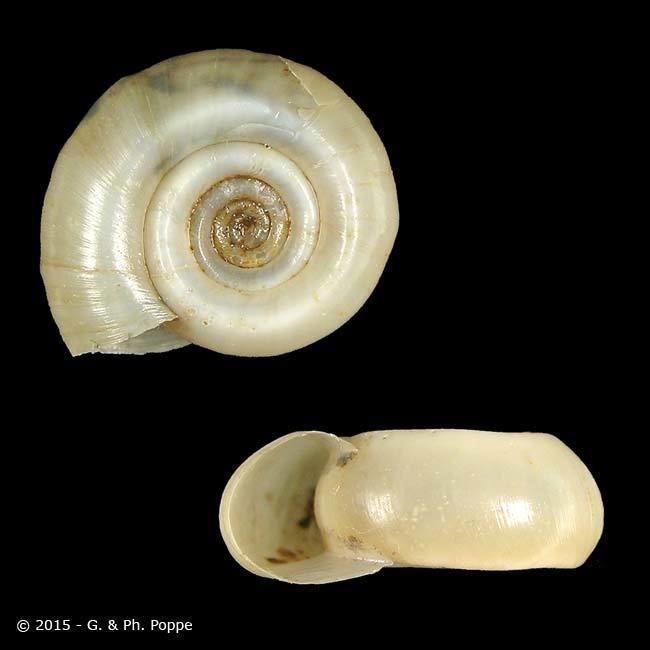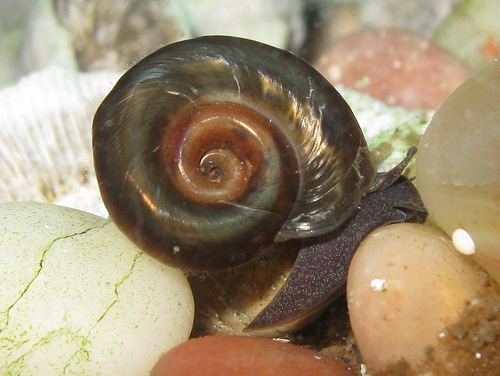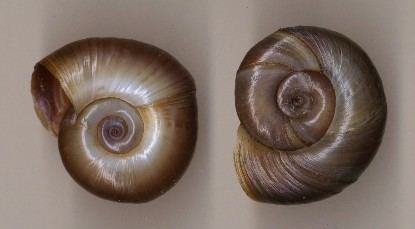Scientific name Planorbidae Higher classification Planorboidea | Superfamily Planorboidea Rank Family | |
 | ||
Lower classifications | ||
Planorbidae ramshorn snail takes a breather
Planorbidae, common name the ramshorn snails or ram's horn snails, is a family of air-breathing freshwater snails, aquatic pulmonate gastropod mollusks.
Contents
- Planorbidae ramshorn snail takes a breather
- Leech cleans snail worries flatworm erpobdella planorbidae
- General taxonomic context
- 2005 taxonomy
- 2007 taxonomy for part of the family
- Cladogram
- Genera
- Shell description
- Sinistral shells
- Blood pigment
- Habitat
- Geological history
- Geographical distribution
- References

Many of the species in this family have coiled shells that are planispiral, in other words, the shells are more or less coiled flat, rather than having an elevated spire as is the case in most gastropod shells. Although they carry their shell in a way that makes it appear to be dextral, the shell of coiled planorbids is in fact sinistral in coiling, but is carried upside down, which makes it appear to be dextral.
The foot and head of planorbids are rather small, while their thread-like tentacles are relatively long.
For information on what are known as "ramshorn snails" in the aquarium trade, some of which (but not all of which) are planorbids, please see ramshorn snail.

Leech cleans snail worries flatworm erpobdella planorbidae
General taxonomic context

For several taxa, no consensus exists as to whether the taxa should even be assigned to the family Planorbidae. This is certainly the case with the freshwater limpets Ferrissia, and Ancylus. Both of these genera have sometimes been assigned to the family Lymnaeidae. Alternatively sometimes each one of them is raised to the level of a family. However, according to the taxonomy of the Gastropoda (Bouchet & Rocroi, 2005), these genera are currently placed in the tribe Ancylini within the family Planorbidae, and that is the taxonomic system that is followed here.
2005 taxonomy
According to the taxonomy of the Gastropoda (Bouchet & Rocroi, 2005), this family consists of the following subfamilies:
2007 taxonomy for part of the family
Albrecht et al. (2007) analyzed a limited number of genera of Planorbidae, based on sequences of mitochondrial 18S ribosomal DNA and cytochrome-c oxidase I (COI) genes, and on the basis of the results, they rearranged the taxonomy like this:
"A-clade" sensu Albrecht et al. (2007)
Tribus Bulinini
Tribus Ancylini Rafinesque-Schmaltz, 1815
"B-clade" sensu Albrecht et al. (2007)
Tribus Camptoceratini
Tribus Planorbini
Tribus Segmentinini
"C-Clade" sensu Albrecht et al. (2007)
Cladogram
The following is a cladogram that shows the phylogenic relationships within the Planorbidae according to Albrecht 2007:
Genera
The type genus of this family is Planorbis Müller. The following list of genera is organized according to the 2005 taxonomy, because Albrecht's 2007 taxonomy is not available for all genera of Planorbidae. Genera in the family Planorbidae include (subgenera listed according to Glöer (2002):
Subfamily = ? (other genera that are not yet sorted are listed here)
- synonym: Afrogyrus Brown & Mandahl-Barth, 1973
The genus Camptoceratops Wenz, 1923 is no longer considered to be a planorbid. It was recognised by Curry (1965, p. 360) as a euthecosomatous pteropod (Heterobranchia) (note by Arie W. Janssen, 092507).
The generic name Taphius H. Adams & A. Adams, 1855 is a synonym for Biomphalaria.
Shell description
The shells of most species in this family are disk-like or button-like, being coiled in one plane, although several groups have shells that are more higher-spired, and some are limpet-like.
All coiled shell Planorbidae are sinistral in their shell coiling, as is proved by their internal anatomy (the respiratory and the genital orifice are situated on the left side), however the animals carry their shells with what would normally be the ventral (i.e. umbilical) surface uppermost, and because of this, the shells appear to be dextral.
Indeed, formerly planorbids were thought to have dextral shells, and so species of this family were figured as if they had dextral shells. Although it is now understood that these species are sinistral in shell coiling, disk-like Planorbid shells are often still shown in illustrations oriented as if they were dextral.
Most species of coiled planorbids have a rather thin and moderately smooth shell, although more distinct sculpture such as a keel occurs in, and is diagnostic of, certain species. In the flat, keeled species, the whorls tend to overlap.
The aperture has a sharp outer lip. A peristome can be present, but often the lip is not thickened nor reflected. Those planorbid species which have a high-spired shell may have a narrow umbilicus, but frequently this is covered by callus.
In height most species vary between 6 mm and 6 cm, however, disk-like shells are usually less than about 2 cm in maximum dimension.
Like all pulmonate aquatic snails, ramshorn shells do not have an operculum to close the shell aperture.
Sinistral shells
Flat-coiled planorbid gastropod shells are hard to understand in terms of their coiling and orientation. Many of the shells of species in this family are almost planispiral in coiling such that one side of the shell often looks rather like the other side, but it is important to bear in mind that nonetheless there is an umbilical side and a spire side of the shell. In addition these are in fact sinistral shells, despite the fact that the snail carries its shell as if it were a normal dextral shell. To make sense of the shell coiling, the following facts are useful:
However, once it is understood that the planorbid shell is sinistral, if the shell is held with the aperture on the left and facing the observer, then the sunken spire side of the shell is uppermost. This is a convenience for understanding the shell, but is the opposite of the way the shell is actually carried in life.
The side of the shell which is in fact the spire (a sunken spire) faces down in the living animal, contrary to what is the case in almost all other shelled gastropods. Because the shell is carried "upside down" like this, the aperture of the shell is angled to face downwards also, so the aperture faces a little towards the spire, not away from it, as is usually the case in other shelled gastropods.
Blood pigment
Contrary to the case in most other molluscs, the blood of ram's-horn snails contains hemoglobin. As a result, these animals are able to breathe oxygen more efficiently than other molluscs. The presence of this substance gives the body a reddish colour. This is especially apparent in albino animals.
Habitat
Most species of planorbids live only in fresh water, such as ponds lake and slow moving rivers. A minority of species are able to survive in brackish water.
Geological history
Ancestors of ramshorn snails are known with certainty since the Jurassic period. Modern taxa developed since the Cretaceous.
Geographical distribution
Species in this family occur worldwide. In Northwest Europe about 20 species are known (including non-indigenous species). In this region, various extinct taxa are known to have occurred, starting in the Jurassic period.
